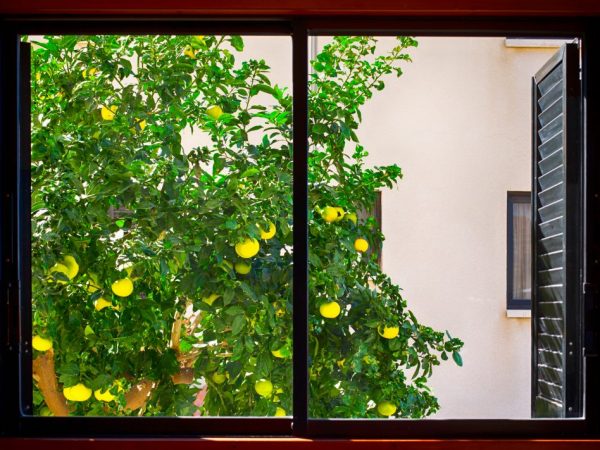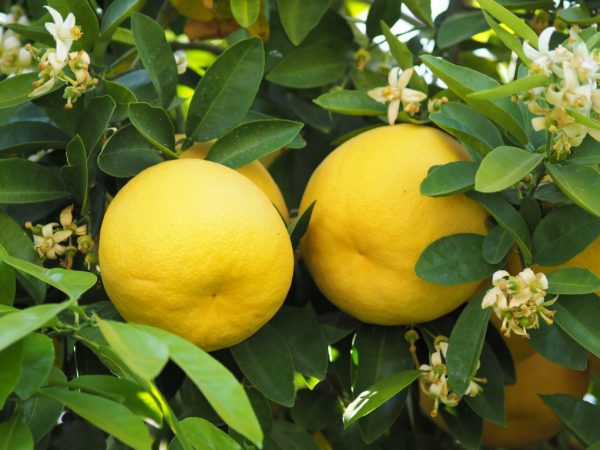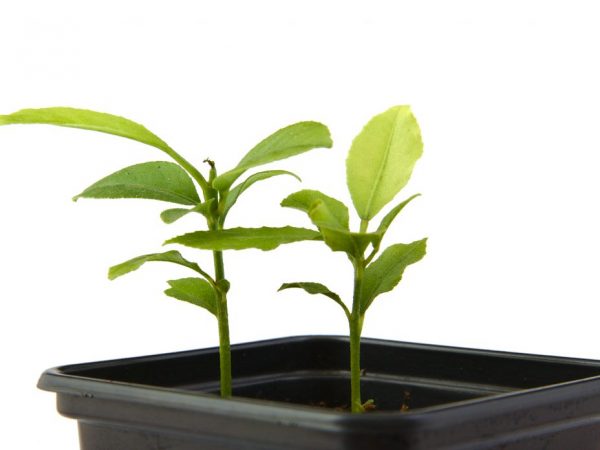How to grow grapefruit at home
Grapefruit grows at home only if the rules of care and cultivation are followed. The culture is rarely planted in the garden: the tree grows only in tropical climates. To grow grapefruit at home, you should choose the right variety: not all of them bear fruit.

Growing grapefruit at home
Description of culture
The ancestor of grapefruit is India and Central America. The grapefruit tree is a hybrid of an orange and a pomelo. The fruits of the culture are considered dietary, they are often used to treat diseases.
The plant is new, found several hundred years ago. For a comfortable development, a tree needs a lot of light, the right climate and a high temperature regime.
Story
The name of the culture comes from 2 English words: "grape" (lane - "grapes") and "fruit" (lane - "fruit"). Scientists call the culture the aciniform pompelmus.
The fruit began to spread actively in the twentieth century. The USA is the largest producer of this crop, more than 85% of the fruits are grown in this country.
Description of fruit and tree
Features of the tree:
- the crown is dense, often rounded;
- it stretches in height by 8 m in open areas, and by 2 m at home;
- large leaves with a blunt end, green in color;
- blooms with flowers of large size with a bright scent;
Features of the fruit:
- rounded shape;
- fruit diameter - up to 13 cm;
- yellow;
- thick peel - up to 1.5 cm;
- elastic and juicy flesh, often of a light shade;
- sweet and sour taste with bitterness;
- large seeds.
Flowering has 2-3 periods. Grapefruit is rich in vitamins and useful nutrients, not inferior even to lemon (up to 50 mg of vitamin C per 100 g of fruit). Red-fleshed citruses are high in vitamin A.
The growing fruit contains proteins such as arginine, alanine, lysine, serine. The peel contains potassium, iron, phosphorus.
Freshly squeezed juice is used to whet the appetite or for high blood pressure.
Growing

The tree bears fruit at home
A freshly planted grapefruit tree feels comfortable on the windowsill.
When the bush grows up, it is transferred to winter gardens, loggias and offices. Under these conditions, the growing trunk reaches a maximum height of 2 m. The grapefruit bears fruit at home.
Common varieties:
- Flame;
- Rio Red;
- Star Ruby;
- Duncan;
- March;
- Red;
- Flame;
- White.
Growing from a bone
Growing grapefruit from seed is the most common type of reproduction of this culture. Planting material - seeds that are in the fruit. For this, fully ripe fruits are used, and only the correct shape is taken out of them. Several seeds are planted, since many are not viable.
The seed is not dried, but immediately planted in a flowerpot, observing the rule of 1 bone - 1 pot. The land must contain peat, river sand is added.
The depth of the planting pit is 2 cm.After planting, the ground is watered with warm water and covered with a plastic bag. The pot is placed in a well-lit and warm place. The greenhouse is ventilated daily and watered with dry soil. The first leaves appear within 2-3 weeks. After that, the package is removed. You need to transplant systematically as soon as the citrus becomes cramped.
Propagation by cuttings
Reproduction by cuttings is carried out either in the spring (March-April) or in the summer (June-July). From an adult grapefruit, 8 shoots are cut, each of which must have at least 6 leaves. Before planting, the growing shoot is placed in wet river sand and a mini-greenhouse is made using a bag. Air temperature - not less than 25 ° С.
The root system appears within 2 weeks. The soil should consist of:
- sand;
- deciduous humus;
- turf land;
- humus.
Drainage is laid out at the bottom of the pot.
Reproduction by grafting
It is also possible to propagate by grafting. It is better to plant citrus in the spring, since the intensity of the juices in the plant is most active. On the rootstock and scion, cuts are neatly made with a special tool.
The diameter of the slices should be similar. The place of the cuts is grafted, while pressing strongly against each other, after which they are wrapped with electrical tape.
Transfer

A young tree is transplanted every year
Before the tree is 5 years old, it is replanted every year. After - less often: once every 3 years. The first sign that a grapefruit should be transplanted is the root system protruding from the flowerpot.
Fresh substrate is added to the ground annually. Loose soil is used for plant transplantation. Soil with a high acidity level is not suitable for this crop. The soil must contain a certain amount of macro- and microelements. Florists add a nail to the ground, since wood requires iron.
Before transplanting, up to 8 cm of drainage is placed on the bottom of the pot: polystyrene, crushed stone. This helps not to stagnate liquid, the root system will not rot. They use the transshipment method (the soil remaining on the root system is transferred to a new flowerpot) so as not to injure the root.
Care
In order for the grapefruit tree to develop well and be rich in fruits, take into account:
- Location and lighting. Daylight hours for this culture should be at least 10 hours. If the windows are in the northern part, artificial lighting is additionally used. In winter, lamps are regularly used, since there is little winter daylight.
- Temperature conditions. The air temperature should be up to 27 ° C. Direct sunlight causes burns. Drafts also interfere with the development of the tree. In autumn and winter, the air temperature is lowered to 4 ° C, so that in the future the grapefruit will bloom and bear fruit.
- Air humidity should be around 60%. For this, spraying with warm water is used in summer and spring. An outdoor shower is held once a month.
- Top dressing. The tree is fertilized from mid-autumn to the end of winter: this is the phase of active growth. Special additives for citrus plants are used twice a month.
- Watering. The soil should always be moist, but it should not be poured over. On hot days, citrus is watered daily, on other days as needed, when the ground is dry. Melt, rain, river and distilled water works well.
From the frequent movement of the flowerpot, citrus throws off foliage and fruits. The ripening period for grapefruit is after 7 years of life.
If the tree has stopped growing, there is not enough fertilizer for it. When the leaves are crumbling, the grapefruit is poured. When the tips of the leaves dry up and curl, the lack of air humidity is to blame.
The plant is systematically examined to detect pests:
- citrus whitefly;
- citrus red mite;
- scabbards.
If the parasite is found, the plant is washed with alcohol, oil or soap solution. The insects are removed by hand with cotton pads.
Conclusion
There are several ways to grow grapefruit at home: with the help of seeds, cuttings and grafting. Wood loves warmth and moisture, i.e.because used to grow in tropical climates.
Grapefruit should not be poured; watering should be daily during the warm season. If the tree doesn't have enough water, it dies. Average daylight hours are 10-12 hours. Avoid direct sunlight: they cause burns.


